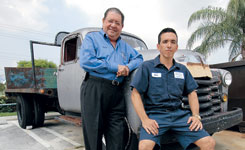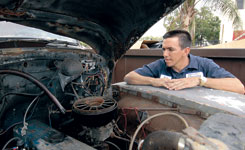|
In the ’60s, at the height of the Cold War, communist Cuba seemed dangerously close to the United States. After all, 90 miles is no distance at all for a nuclear-tipped ballistic missile.
But the Florida Strait is treacherous — a tough 90 miles to cover in any boat. With the Gulf Stream surging through along with the strong Florida Current, it’s usually windy with heavy swells. In hurricane season, the murderous storms seem to head right into it. Of course, there are plenty of sharks, too.
But it’s vastly more perilous crossing it in a Chevrolet, Buick, or Mercury.
“In the ocean the biggest boat is still, like, a little thing,” explains Luis Grass, now 38, who in July 2003 took 11 of his family and friends and almost made it to the U.S. aboard a green 1951 Chevrolet two-ton truck he had made, if not strictly seaworthy, at least seaworthy enough.
Whatever the motivation — economic, political, religious, or familial — Cubans have a massive incentive to risk their lives trying to make it to the U.S. “The way it works is that any Cuban who reaches the United States is automatically entitled to stay,” says David Abraham, a professor of immigration and citizenship law at the University of Miami, explaining the situation created by the Cuban Adjustment Act of 1966, “and after one year, to pursue citizenship. This is not offered to any other country’s citizens. It doesn’t matter if that’s Haiti, Canada, or Jamaica. Cuba is the only exception. The issue then is: What does it mean to reach?”
Currently, reach means, in practical terms, setting foot on dry land. “It’s the wet-foot/dry-foot agreement,” Abraham explains, describing the compromise policy that emerged after the 1994 balsero (“rafter”) crisis, when Fidel Castro responded to riots in Havana by announcing that his government would no longer prevent “illegal” departures and thousands of Cubans fled the island on makeshift rafts. “If they reach the shore,” Abraham continues, “they stay. But if they’re interdicted at sea, they get a quick interview to determine if, as individuals, they are at risk of being persecuted and, if not, they’re sent back to Cuba. What this generates is people who will fight off the Coast Guard to make the shore. Having dry feet means you’re home free.”
 Luis Grass has the taut, lean body of the tae kwon do competitor he was in Cuba (he says he holds a black belt in the martial art). If he’s taller than five foot six, it’s not by much, and his perfect posture makes every one of those inches count. Even though his grasp of English is slight (and this writer’s Spanish worse), he looks you straight in the eye as you speak, apparently out of courtesy and a sincere attempt to understand all that he can. He’s quick, animated, and obviously smart. He’s also a confident man, someone fearless enough to load himself, his second wife, Isora, and his young son, Angel Luis, along with nine friends, aboard a 52-year-old truck and drive it into the Atlantic Ocean, trusting that his craftsmanship, navigation skills, and cheap compass would get them to Florida. Luis Grass has the taut, lean body of the tae kwon do competitor he was in Cuba (he says he holds a black belt in the martial art). If he’s taller than five foot six, it’s not by much, and his perfect posture makes every one of those inches count. Even though his grasp of English is slight (and this writer’s Spanish worse), he looks you straight in the eye as you speak, apparently out of courtesy and a sincere attempt to understand all that he can. He’s quick, animated, and obviously smart. He’s also a confident man, someone fearless enough to load himself, his second wife, Isora, and his young son, Angel Luis, along with nine friends, aboard a 52-year-old truck and drive it into the Atlantic Ocean, trusting that his craftsmanship, navigation skills, and cheap compass would get them to Florida.
 In Havana, Grass made a living hauling sugar cane with his Chevy truck to make guarapo (a beverage based on sugar-cane juice) and running an illegal car-repair shop. When the Cuban government closed his shop and confiscated the truck when he tried to change its title, he decided the time had come to head for Florida. “They took everything away from me — the paperwork and the keys. But I had an extra spare key in the glove compartment.” So he used that key to retrieve the truck from the military depot where the government had stored it — a place so chaotic with activity he’s not sure they ever knew he took it back. He drove it to his friend Marciel Basanta’s house and hid it. “After about 12 days, my wife and some friends went to the beach, and I was looking out at the horizon, and I told my wife, ‘You know, my love, we have to do this. That’s the only way to get out of here. I have no other choice.’” In Havana, Grass made a living hauling sugar cane with his Chevy truck to make guarapo (a beverage based on sugar-cane juice) and running an illegal car-repair shop. When the Cuban government closed his shop and confiscated the truck when he tried to change its title, he decided the time had come to head for Florida. “They took everything away from me — the paperwork and the keys. But I had an extra spare key in the glove compartment.” So he used that key to retrieve the truck from the military depot where the government had stored it — a place so chaotic with activity he’s not sure they ever knew he took it back. He drove it to his friend Marciel Basanta’s house and hid it. “After about 12 days, my wife and some friends went to the beach, and I was looking out at the horizon, and I told my wife, ‘You know, my love, we have to do this. That’s the only way to get out of here. I have no other choice.’”
 His wife and friends came to the conclusion that he was nuts. But he was determined, so he went home, drew up some plans, and then started scheming ways to scrounge together the necessary parts and pieces to turn his truck into an ocean liner of sorts. His wife and friends came to the conclusion that he was nuts. But he was determined, so he went home, drew up some plans, and then started scheming ways to scrounge together the necessary parts and pieces to turn his truck into an ocean liner of sorts.
Grass had more than just intuition to apply when modifying his truck. He had trained as a naval engineer in Cuba but dropped out of the program during the fourth of his six years of study when, he says, the military commitment and the Communist Party membership that go with such training kicked in. So, on an island nation where private ownership of boats is illegal, he was one of the few people who knew how to build them.
|

